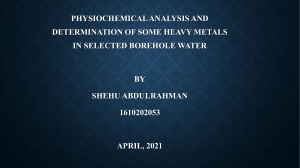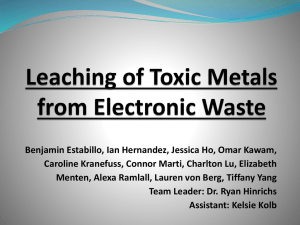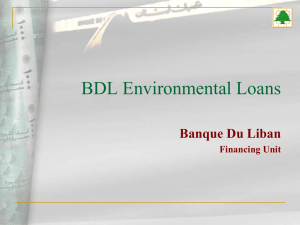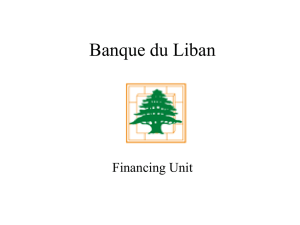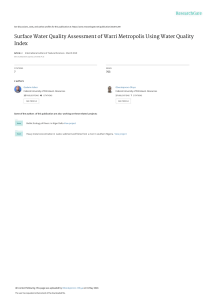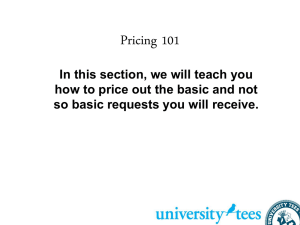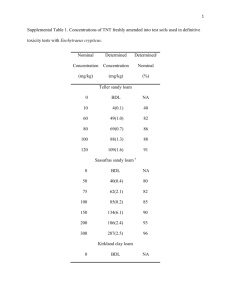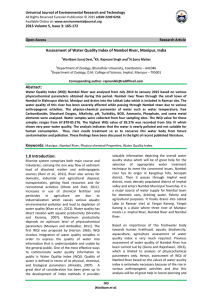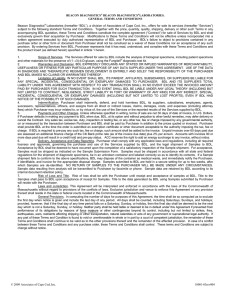Document 12908568
advertisement
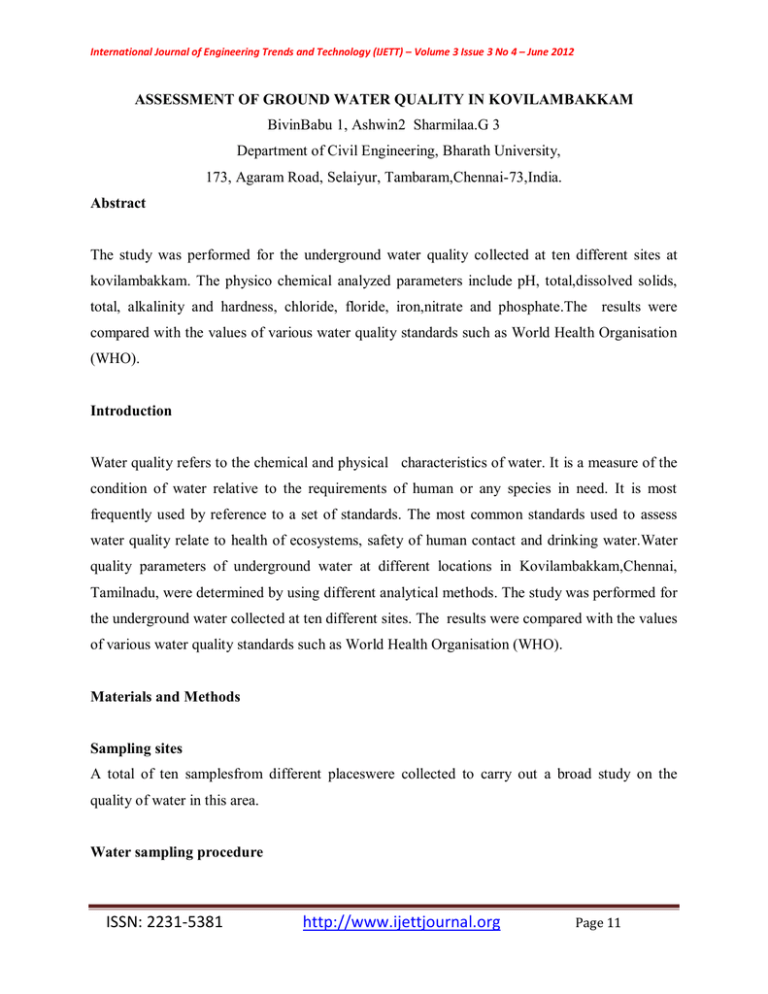
International Journal of Engineering Trends and Technology (IJETT) – Volume 3 Issue 3 No 4 – June 2012 ASSESSMENT OF GROUND WATER QUALITY IN KOVILAMBAKKAM BivinBabu 1, Ashwin2 Sharmilaa.G 3 Department of Civil Engineering, Bharath University, 173, Agaram Road, Selaiyur, Tambaram,Chennai-73,India. Abstract The study was performed for the underground water quality collected at ten different sites at kovilambakkam. The physico chemical analyzed parameters include pH, total,dissolved solids, total, alkalinity and hardness, chloride, floride, iron,nitrate and phosphate.The results were compared with the values of various water quality standards such as World Health Organisation (WHO). Introduction Water quality refers to the chemical and physical characteristics of water. It is a measure of the condition of water relative to the requirements of human or any species in need. It is most frequently used by reference to a set of standards. The most common standards used to assess water quality relate to health of ecosystems, safety of human contact and drinking water.Water quality parameters of underground water at different locations in Kovilambakkam,Chennai, Tamilnadu, were determined by using different analytical methods. The study was performed for the underground water collected at ten different sites. The results were compared with the values of various water quality standards such as World Health Organisation (WHO). Materials and Methods Sampling sites A total of ten samplesfrom different placeswere collected to carry out a broad study on the quality of water in this area. Water sampling procedure ISSN: 2231-5381 http://www.ijettjournal.org Page 11 International Journal of Engineering Trends and Technology (IJETT) – Volume 3 Issue 3 No 4 – June 2012 Plastic bottles of 1.5 liter capacity with stopper were used for collecting samples. Each bottle was washed with 2% Nitric acid and then rinsed three times with distilled water. The bottles were then preserved in a clean place. The bottles were filled leaving no air space, and then the bottle was sealed to prevent any leakage. Each container was clearly marked with the name and date of sampling. Methodology The samples collected on a day were immediately processed for physiochemical and bacteriological analysis as per standard methods.The samples were analyzed for different parameters. The physico chemical analyzed parameters include pH, total,dissolved solids, total, alkalinity and hardness, chloride, floride, iron,nitrate and phosphate and tabulated in table 2. Water Quality Index The water quality index (WQI) gives overall quality of water on the basis of large number of physico-chemical characteristics of water.Water Quality Index (WQI) is a most efficient method for assessing the quality of water. Water Quality Index (WQI) is a tool for communicating the information on overall quality of water and rates the quality of each sample locations. It acts as the perfect indicator of the quality of the water. It was first proposed by Horton (1965) to determine the suitability of the groundwater for drinking purposes. Analyzed groundwater sample data are tabulated in Table1. WQI is computed adopting the following formula. n Wi q i WQI i 1 n Wi i 1 Where, W is the unit weightage factor computed using the following equation, Wn K / S n and K is the proportionality constant derived from, 1 K n1 n 1 S i ISSN: 2231-5381 http://www.ijettjournal.org Page 12 International Journal of Engineering Trends and Technology (IJETT) – Volume 3 Issue 3 No 4 – June 2012 where S n and S i are the Bureau of Indian Standard values of the water quality parameter (Table 2). Quality rating is calculated using the formula, V Videal q ni actual x100 Vs tan dard Videal Where, qni is the quality rating of ith parameter for a total of n number of water quality parameters. Vactual is the value of the water quality parameter obtained from laboratory analysis. Videal is the value of the water quality parameter can be obtained from the standard tables. Videal for pH is 7,and Dissolved Oxygen is 14.6 mg/lit and for other parameters it is equivalent to zero. V s tan dard is the BIS standard of the water quality parameter. Based on the WQI values, the water quality is rated as excellent, good, poor, very poor, and unfit for human consumption (Table 1). Table 1 : Quality rating of water on the basis of WQI (by Tiwari and Mishra, 1985) WATER QUALITY INDEX DESCRIPTION 0-25 Excellent 26-50 Good 51-75 Poor 76-100 Very Poor >100 Unfit For Drinking Table 3 Water Quality Index Ranges in the Kovilambakkam Results and Discussion ISSN: 2231-5381 http://www.ijettjournal.org Page 13 International Journal of Engineering Trends and Technology (IJETT) – Volume 3 Issue 3 No 4 – June 2012 The study area has pH ranging from 6.3 – 7.5. All sampling sites have a normal pH value. Total alkalinity of water varied from 380 – 500 mg/l. . Total hardness was found in the sample water ranges from 340 -700 mg/l, which is not in the permissible limits.The results of water investigation show that the waters of the study area are highly contaminated with total dissolved solids. As a result of high concentration of TDS, water loses its pot ability and reduces the solubility of oxygen in water.The nitrate level in the study area are within the permissible limit. Chlorides also have high values and are greater than the permissible limit Table 2Water quality parameters All the Sample No parameters are in 1 2 3 4 5 6 7 8 9 10 7.5 6.3 7.4 7.4 7.3 7.4 7 7.3 7.1 7.5 510 410 400 400 380 420 380 350 370 420 1753 1030 1520 1562 1670 1740 1550 1335 1400 1560 500 340 600 750 620 600 550 600 530 700 Chlorides 340 110 300 300 240 360 500 280 330 320 Nitrate 44 20 25 20 20 25 30 20 20 25 Fluoride 1.5 1 .5 0.5 0.5 0.5 0.5 0.5 0.5 0.5 Phosphate 5 3 .3 0.5 0.5 2 0.5 0.5 0.5 5 Iron BDL BDL BDL BDL BDL BDL BDL BDL BDL BDL mg/l,except pH pH Total Alkalinity Total Dissoved solids Total Hardness BDL-Below detection Limit ISSN: 2231-5381 http://www.ijettjournal.org Page 14 International Journal of Engineering Trends and Technology (IJETT) – Volume 3 Issue 3 No 4 – June 2012 Table 3 Water Quality Index Ranges in the Kovilambakkam sample 1 2 3 4 5 6 7 8 9 10 WQI 37.24 23.21 13.43 85.76 20.16 13.42 13.68 87.92 13.69 12.31 Conclusion The ground water samples collected from the various places in kovilambakkam were analyzed for variousphysicochemical parameters. The general observation from the results is that the water is considerable for drinking and all other domestic purposes. Overall contribution of the parameters says that the groundwater quality is not bad throughout the study area. As per the study, the TDS values are high than the prescribed values of WHO but this can be controlled using reverse osmosis methods. References [1] APHA.Standard methods of the examination of water and waste water (18th edu).American Public HealthAssociation, New York, 1998, 11-20. [2] BIS, Specification for drinking water. Bureau of Indian Standards, New Delhi 1998, 171-178. [3] Jain C.K and etal.Assesment of ground water quality for drinking water purpose, District Nainital, Utarkhanda,India, Environ monit Assess, springer, (2009) 166,663-673 [4] Rajgopal; Groundwater quality assessment for public policy in India.1st Annual report. Department ofgeography, IOWA University, IOWA.1984, 10-11. [5] Trivedi R.K. and Goel P.K. ; Chemical and Biological methods for water and soil pollution studies, Environmental publication, India (1986) [6] Vogel’s Text Book of Quantitative Chemical Analysis, Jeffery G.H, Basset J, mendham J and Denny RC, 5thEd, ELBS, 1989. ISSN: 2231-5381 http://www.ijettjournal.org Page 15 International Journal of Engineering Trends and Technology (IJETT) – Volume 3 Issue 3 No 4 – June 2012 [7] WHO, World Health Organisation, International Standard Standards for Drinking Water, Geneva, Switzerland,1992. [8] World Health Organization, Group on the Water Quality Studies, 1984. Geneva, a Guide for Collection and Interpretation of Water Quality Data. Geneva, Vol. 3, pp. 18-20 ISSN: 2231-5381 http://www.ijettjournal.org Page 16
